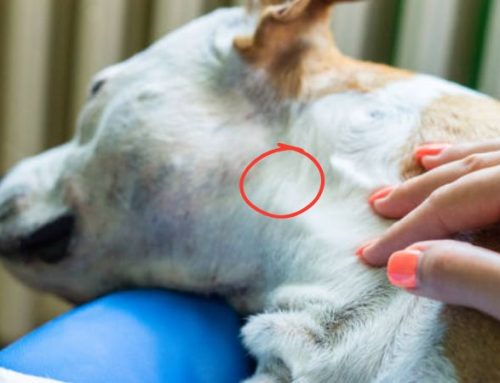Cats are famously meticulous groomers, spending hours each day keeping their coats clean and sleek. But even the most fastidious feline can sometimes need a little extra help whether it’s dealing with pesky fleas, soothing dry, itchy skin, or managing stubborn dandruff. While store-bought shampoos are convenient, many contain harsh chemicals that can irritate sensitive skin or disrupt a cat’s natural coat balance.
That’s where homemade cat shampoo comes in. By crafting your own natural, DIY formulas, you gain complete control over the ingredients, ensuring they’re safe, gentle, and tailored specifically to your cat’s needs. From soothing oatmeal blends to gentle vinegar rinses, these six tried-and-true recipes make bath time a healthier, safer, and even more enjoyable experience for both you and your furry companion.
Key Ingredients for Natural Cat Shampoo DIY

1. Coconut Oil
Coconut oil is one of the most popular ingredients in homemade cat shampoos, and for good reason:
- Moisturizes and conditions fur: Coconut oil penetrates the hair shaft, leaving coats soft, shiny, and manageable.
- Soothes dry or irritated skin: Its natural fatty acids help calm inflammation and prevent itching.
- Natural antimicrobial properties: Coconut oil can help reduce minor bacterial or fungal issues on the skin.
- Why it’s used: Safe in small amounts and easily absorbed, coconut oil is ideal for cats with sensitive skin or dry fur.
2. Oatmeal
Oatmeal is another favorite in DIY cat shampoo recipes, particularly for cats with dry, itchy, or irritated skin:
- Soothes irritation: Colloidal oatmeal coats the skin and reduces itchiness caused by allergies or dandruff.
- Hydrates and protects: Oatmeal forms a natural barrier that locks in moisture, preventing dryness.
- Gentle cleanser: It cleans fur without stripping natural oils, making it perfect for sensitive cats.
- Common use: DIY oatmeal cat shampoo often blends finely ground oatmeal with warm water to create a paste or liquid shampoo base.
3. Aloe Vera
Aloe vera is well-known for its healing and calming properties:
- Reduces redness and inflammation on the skin.
- Promotes skin repair and can relieve mild sunburns or irritation.
- Adds a gentle slip to the shampoo, making fur easier to detangle.
- Must use pure, pet-safe aloe vera gel without additives or alcohol.
4. Apple Cider Vinegar (ACV)
ACV is often used in natural pet shampoos for its balancing and protective properties:
- Balances pH: Helps maintain the natural acidity of cat skin.
- Repels fleas: Its scent and acidic nature can help deter minor flea infestations.
- Reduces odors: ACV naturally deodorizes without harsh chemicals.
- Always dilute properly (usually 1 part vinegar to 3–4 parts water) to prevent irritation.
5. Safe Essential Oils
While many essential oils are toxic to cats, certain oils can be used very sparingly for added benefits:
- Lavender: Calming and mildly antibacterial; use just a drop or two.
- Chamomile: Soothes irritation and promotes a healthy coat.
- Tips: Never use oils directly on a cat; always dilute heavily, and avoid strong oils like tea tree, peppermint, eucalyptus, or citrus, which are toxic to cats.
How Natural Ingredients Address Common Cat Skin Issues
- Fleas: Coconut oil, diluted ACV, and certain safe essential oils can help repel fleas naturally.
- Dandruff: Oatmeal and aloe vera soothe dry, flaky skin while moisturizing the coat.
- Sensitive skin: Gentle, chemical-free ingredients reduce irritation, itching, and allergic reactions.
By combining these ingredients thoughtfully, homemade cat shampoo can be safe, effective, and tailored to your cat’s individual needs, all while avoiding harsh chemicals found in many commercial shampoos.
How to Make Homemade Cat Shampoo for Fleas
Keeping your cat free from fleas can be challenging, especially if you prefer natural solutions. Homemade cat shampoos can be a safe and effective way to repel fleas while nourishing your cat’s skin and coat. By using gentle, cat-safe ingredients, you avoid harsh chemicals found in commercial products and reduce the risk of irritation.
Recipe #1: Flea-Repellent Homemade Cat Shampoo with Natural Oils
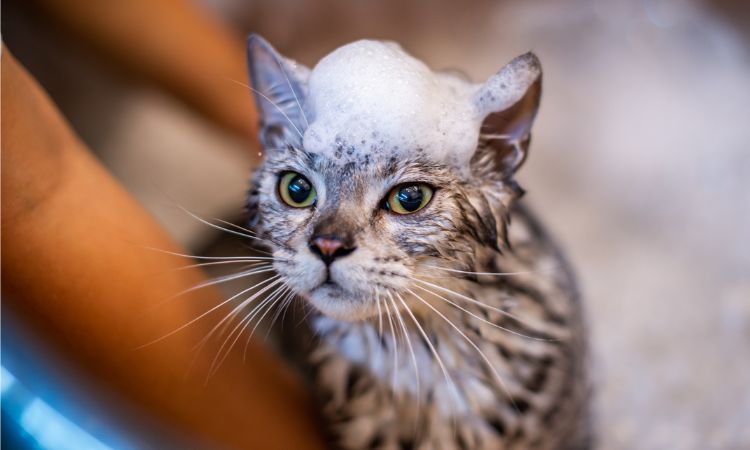
Ingredients:
- 1 cup liquid Castile soap (unscented, gentle, and safe for cats)
- 1 cup warm water
- 1 tablespoon coconut oil (conditions fur and helps repel fleas)
- 1 teaspoon apple cider vinegar (helps deter fleas and balances skin pH)
- Optional: 1–2 drops of cat-safe essential oil such as lavender or chamomile (avoid essential oils toxic to cats, like peppermint, tea tree, eucalyptus, or lemon)
Instructions:
- Mix the Castile soap and warm water in a clean container.
- Add the coconut oil and apple cider vinegar, stirring gently to combine.
- If desired, add the optional cat-safe essential oil and mix thoroughly.
- Transfer the mixture to a foaming pump bottle or standard shampoo bottle for easy use.
Key Tips on Usage and Safety Precautions
- Patch Test First: Apply a small amount to a limited area of your cat’s skin and monitor for irritation before a full bath.
- Avoid Sensitive Areas: Keep the shampoo away from your cat’s eyes, ears, nose, and mouth.
- Rinse Thoroughly: Any residue left on the fur can cause irritation, especially since cats groom themselves frequently.
- Use Lukewarm Water: Hot water can dry out your cat’s skin and coat, reducing the shampoo’s effectiveness.
- Moderation is Key: Limit bathing to necessary situations; over-bathing can strip natural oils from your cat’s fur.
Complementing Homemade Shampoo with Flea Prevention Practices
While flea-repellent shampoos can reduce the number of adult fleas, they do not kill eggs or larvae. To maximize flea control:
- Regular Flea Combing: Use a fine-toothed flea comb to remove adult fleas and flea dirt from your cat’s coat.
- Clean Living Spaces: Wash bedding, vacuum floors, and treat carpets to remove eggs and larvae.
- Vet-Approved Flea Preventatives: Consider combining natural shampoo with products like Revolution Plus or Advantage Multi as recommended by your veterinarian.
- Monitor for Symptoms: Watch for signs of flea allergy dermatitis or excessive scratching, and consult your vet if issues persist.
Related Reads:
- How long should i wait to bathe my cat after giving birth
- What soap to use on cats
- Home remedies for fleas on cats
Homemade Cat Shampoo Recipes for Dandruff & Dry Skin
Cats, like humans, can suffer from dry, flaky skin, which often results in dandruff, itching, and discomfort. Using gentle, natural ingredients in homemade shampoos can help soothe irritation, restore moisture, and improve the overall health of your cat’s coat. Below are two effective DIY recipes specifically designed to tackle dandruff and dry skin, along with explanations of how each ingredient benefits your feline friend.
Recipe #2: Oatmeal-Based Shampoo for Dandruff Relief

Ingredients:
- 1 cup finely ground oatmeal (organic preferred)
- 4 cups warm water
- 1 teaspoon mild cat-safe liquid soap (unscented and dye-free, e.g., Castile soap)
- Optional: ½ teaspoon aloe vera gel for extra soothing
Instructions:
- Grind oatmeal into a fine powder to ensure it mixes smoothly with water.
- In a container, combine oatmeal, warm water, and cat-safe liquid soap. Mix gently until fully blended.
- Add aloe vera gel if using, which enhances soothing properties.
- Wet your cat’s fur with lukewarm water.
- Apply the shampoo mixture evenly, massaging gently into the coat and directly onto the skin.
- Leave for 2–3 minutes to allow the oatmeal and aloe to soothe irritated areas.
- Rinse thoroughly with warm water to remove all residue.
Benefits of Key Ingredients:
- Oatmeal: Naturally anti-inflammatory, oatmeal calms itching and redness, while its fine particles help exfoliate dead skin cells, reducing dandruff.
- Aloe Vera: Hydrates the skin, reduces irritation, and promotes healing of dry or inflamed patches.
- Mild Soap: Provides gentle cleansing without stripping essential oils, unlike harsh detergents.
This oatmeal-based shampoo is ideal for cats experiencing dry, flaky skin or mild irritation. Regular use can help restore the natural balance of the skin and reduce dandruff.
Recipe #3: Coconut Oil-Infused Shampoo for Moisturizing and Dandruff Prevention
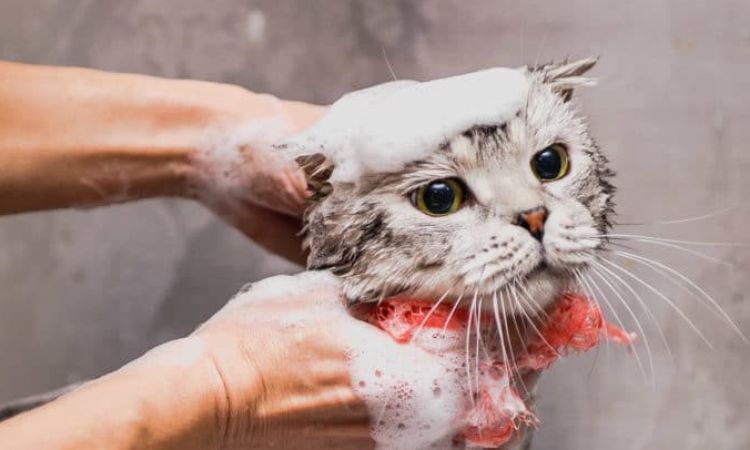
Ingredients:
- 4 cups warm water
- 2 tablespoons coconut oil (organic, unrefined)
- 1 teaspoon mild, cat-safe liquid soap (unscented Castile soap or similar)
- Optional: a few drops of cat-safe essential oil (e.g., chamomile) for fragrance
Instructions:
- Warm the coconut oil slightly until it becomes liquid.
- In a bowl or container, combine warm water, coconut oil, and cat-safe soap. Stir or shake gently until blended.
- Wet your cat with lukewarm water and apply the mixture evenly across the fur.
- Massage thoroughly, focusing on dry or flaky areas.
- Leave on the coat for 2–3 minutes for moisturizing benefits.
- Rinse completely to ensure no oil or soap residue remains.
Benefits of Key Ingredients:
- Coconut Oil: Rich in fatty acids, coconut oil penetrates the fur and skin to provide deep hydration. It helps reduce dryness, prevents flaking, and adds a healthy shine to the coat. Coconut oil also has mild antimicrobial properties that can support skin health.
- Mild Soap: Gently cleanses without removing natural oils, which is crucial for preventing further dryness.
- Optional Chamomile: Adds soothing, anti-inflammatory effects for cats with sensitive skin.
This coconut oil-infused shampoo works best as a moisturizing treatment, preventing dandruff and promoting soft, shiny fur. It’s especially beneficial for cats prone to dry climates or seasonal shedding.
Tips for Using Homemade Shampoos for Dry Skin:
- Always use lukewarm water to prevent further drying of the skin.
- Avoid over-bathing—1–2 times per month is typically sufficient for cats with dry skin.
- Thorough rinsing is essential, as leftover shampoo or oil can cause irritation or attract dirt.
- Patch-test any new ingredient before full application to ensure your cat does not react adversely.
By using natural, gentle ingredients like oatmeal and coconut oil, these homemade shampoos not only reduce dandruff and soothe dry skin but also promote a healthy, shiny coat without exposing your cat to harsh chemicals.
Gentle Homemade Cat Shampoo Recipes for Sensitive Skin
Cats with delicate or sensitive skin require shampoos that are ultra-gentle, free from harsh chemicals, and formulated to hydrate and soothe. These DIY cat shampoo recipes avoid dish soap and other strong detergents, instead using natural ingredients that help maintain healthy fur, calm irritation, and reduce dryness.
Recipe #4: Hypoallergenic Cat Shampoo (No Harsh Chemicals)
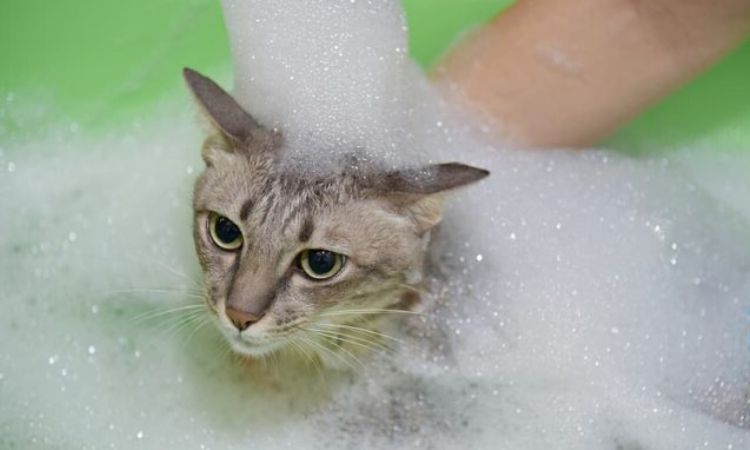
Ingredients:
- 1 cup liquid castile soap (unscented)
- 1 cup warm distilled water
- 1 tablespoon coconut oil (optional, for moisturizing)
- ½ teaspoon vitamin E oil (optional, for skin health)
Instructions:
- Combine all ingredients in a clean container and mix gently until fully blended.
- Wet your cat’s fur with lukewarm water.
- Apply the shampoo evenly, massaging gently into the fur and skin.
- Rinse thoroughly with warm water, ensuring no residue is left.
- Dry your cat with a soft towel.
Benefits:
- Castile soap: Gentle, plant-based cleanser that won’t irritate sensitive skin.
- Coconut oil: Moisturizes and nourishes dry fur without clogging pores.
- Vitamin E: Supports skin health and can help reduce inflammation.
Tip: This hypoallergenic shampoo is ideal for cats prone to allergic reactions or skin sensitivities.
Recipe #5: Aloe Vera & Chamomile Soothing Shampoo

Ingredients:
- 1 cup aloe vera gel (pure, unscented)
- 1 cup brewed chamomile tea (cooled)
- 1 cup warm water
- 1 teaspoon liquid castile soap (optional, for light cleansing)
Instructions:
- Brew chamomile tea and allow it to cool completely.
- Mix chamomile tea, aloe vera gel, water, and castile soap in a container.
- Wet your cat’s fur with lukewarm water and gently apply the mixture, avoiding eyes and ears.
- Massage the shampoo through the coat and rinse thoroughly.
- Pat dry with a soft towel.
Benefits:
- Aloe vera: Hydrates, soothes, and reduces redness or irritation.
- Chamomile: Naturally calming, with anti-inflammatory properties for itchy or sensitive skin.
- Light soap content: Cleans without stripping essential oils from the fur.
Tip: Perfect for cats recovering from mild skin irritation or those prone to flakiness and redness.
Recipe #6: Lightweight Daily Shampoo for Regular Baths
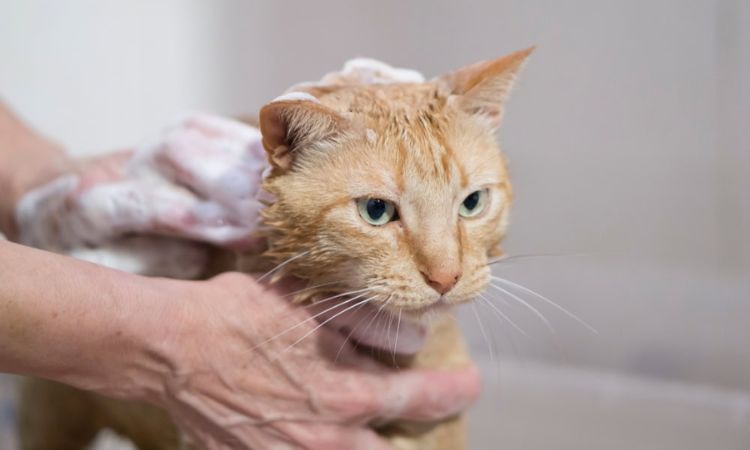
Ingredients:
- 1 cup distilled water
- ½ cup unscented, mild baby shampoo or pure castile soap
- 1 teaspoon jojoba oil (for fur softness)
- Optional: a few drops of cat-safe herbal infusion (like calendula)
Instructions:
- Combine all ingredients in a pump or squeeze bottle and mix gently.
- Wet your cat’s fur with lukewarm water.
- Apply the shampoo lightly, massaging gently and avoiding eyes, nose, and mouth.
- Rinse thoroughly to remove all traces.
- Dry your cat with a towel.
Benefits:
- Jojoba oil: Lightweight, non-greasy moisturizer for everyday use.
- Mild soap or castile: Gentle cleansing without drying out fur or skin.
- Herbal infusion (optional): Adds soothing and calming effects.
Tip: This formula is ideal for routine bathing to maintain clean, soft, and healthy fur without causing dryness or irritation.
General Safety Notes for Homemade Cat Shampoos:
- Always avoid dish soap, human shampoo, and essential oils toxic to cats.
- Test any new homemade shampoo on a small patch of skin first.
- Never get shampoo in your cat’s eyes, ears, or mouth.
- Rinse thoroughly to prevent residue buildup, which can cause irritation.
These three recipes provide gentle, safe, and effective ways to keep your cat clean, calm, and comfortable, whether for sensitive skin, daily maintenance, or soothing irritation.
How to Use Homemade Cat Shampoo Safely
Bathing a cat can be a stressful experience for both pets and owners. Using homemade cat shampoo safely requires careful attention to techniques, timing, and your cat’s comfort. Following these best practices ensures your cat stays clean without irritation, stress, or harm.
1. Bathing Tips and Frequency Recommendations
- Frequency: Most cats do not need frequent baths because they groom themselves effectively. For cats with sensitive skin, dandruff, or mild odor, a bath every 4–6 weeks is generally sufficient. Over-bathing can strip natural oils, causing dry skin and brittle fur.
- Preparation: Gather all supplies before starting, including your homemade shampoo, a non-slip mat, towels, and a container of lukewarm water. This reduces stress by avoiding interruptions during the bath.
- Temperature: Use lukewarm water (not hot or cold) to prevent discomfort and maintain skin hydration.
2. Ensuring Your Cat Is Calm and Comfortable
- Acclimation: Before bathing, let your cat explore the bathing area to reduce anxiety. Gentle petting and calm voices help them relax.
- Secure positioning: Place your cat in a sink, shallow tub, or basin with a non-slip surface to prevent slipping or panic.
- Restraint techniques: If necessary, wrap your cat loosely in a towel and gently hold them, leaving the head exposed. Avoid forcing or holding too tightly, as this can cause stress or injury.
- Positive reinforcement: Offer treats or soft praise during and after the bath to create a positive association with the experience.
3. Proper Application and Rinsing
- Shampoo application: Wet your cat’s fur thoroughly with lukewarm water, avoiding the face, eyes, ears, and mouth. Apply the homemade shampoo gently, massaging from head to tail to ensure even coverage and contact with the skin.
- Rinsing thoroughly: Residual shampoo can irritate the skin, cause itching, or upset your cat’s stomach if ingested during self-grooming. Rinse multiple times with lukewarm water until no suds remain. Pay special attention to folds, underarms, and tail areas.
- Face cleaning: Use a damp washcloth to gently clean around the eyes, nose, and ears instead of applying shampoo directly.
4. Drying Techniques
- Towel drying: Immediately wrap your cat in a soft towel and gently pat dry. Avoid vigorous rubbing, which can tangle fur or irritate the skin.
- Optional air or blow drying: If your cat tolerates it, a low-heat, low-speed blow dryer can help. Always maintain a safe distance to prevent burns and keep the noise level minimal to reduce stress.
- Brushing: Once mostly dry, gently brush your cat’s fur to remove tangles, distribute natural oils, and enhance coat shine.
5. Additional Safety Tips
- Always check ingredients in your homemade shampoo to ensure they are safe for cats, avoiding dish soap, human shampoos, and essential oils that are toxic to felines.
- Test new shampoos on a small area of your cat’s skin before full application.
- Maintain a calm environment and take breaks if your cat becomes too anxious.
Following these guidelines ensures that homemade cat shampoos are used safely and effectively, keeping your cat clean, healthy, and comfortable without irritation or stress.





